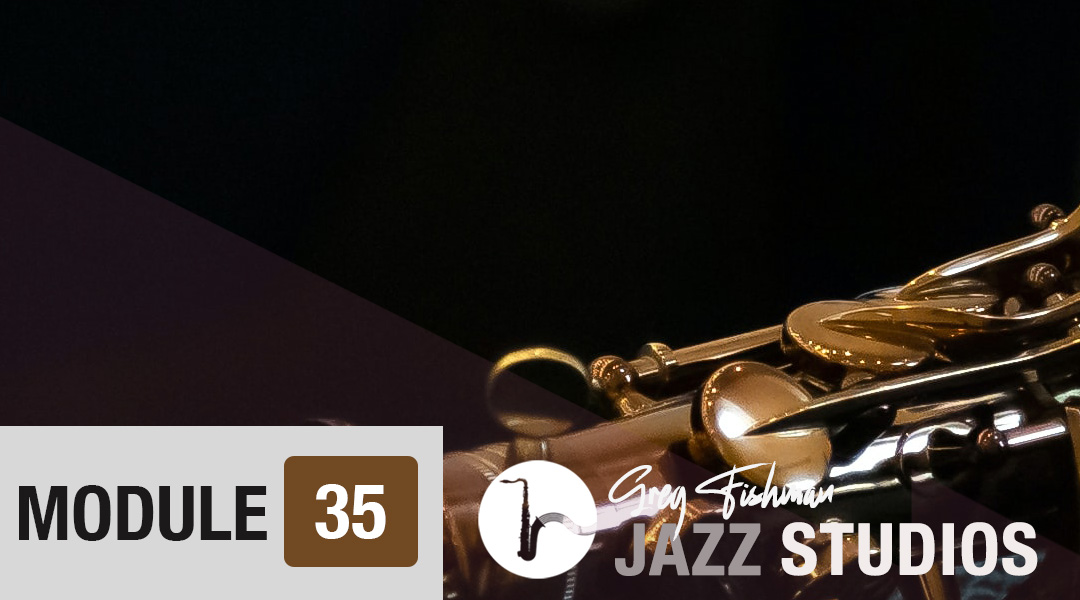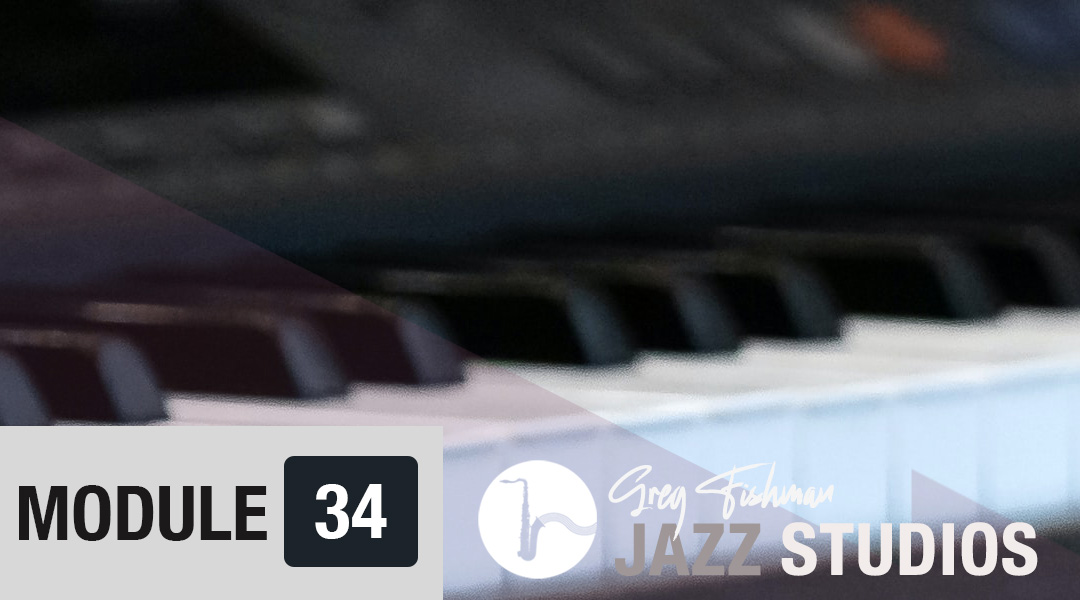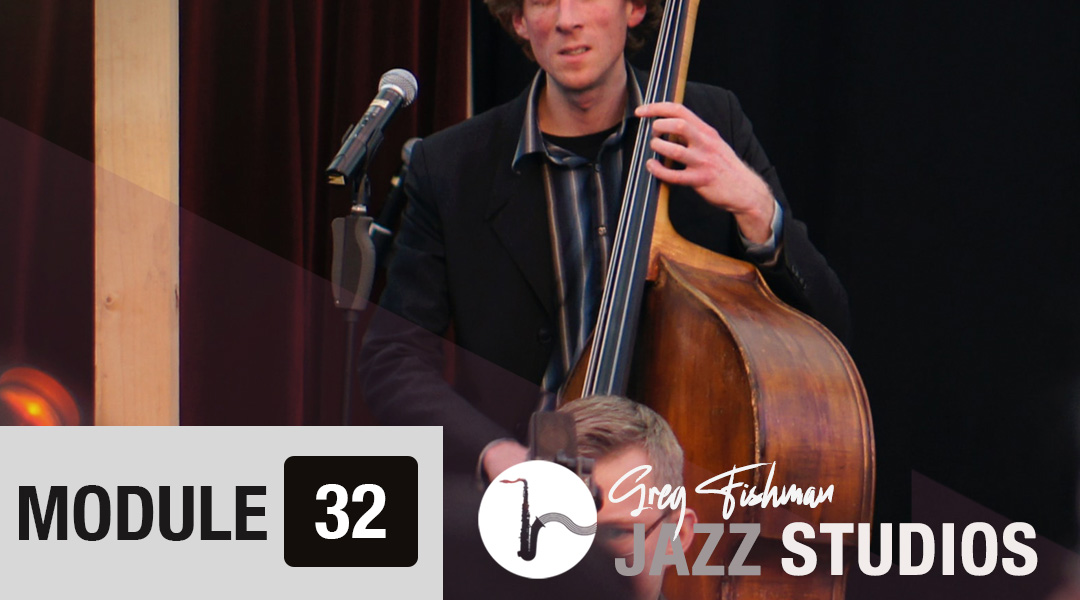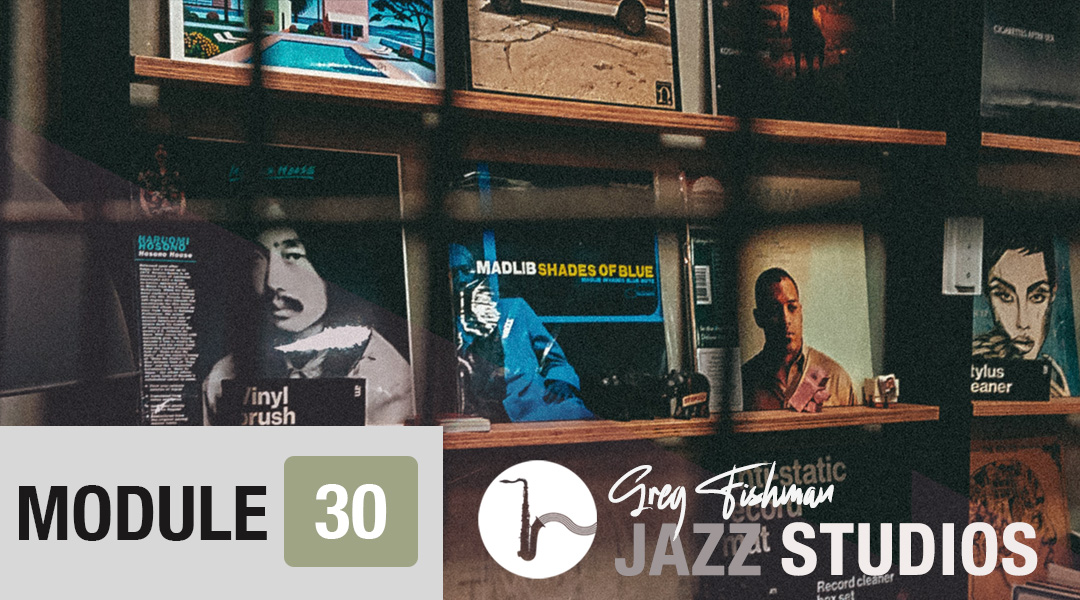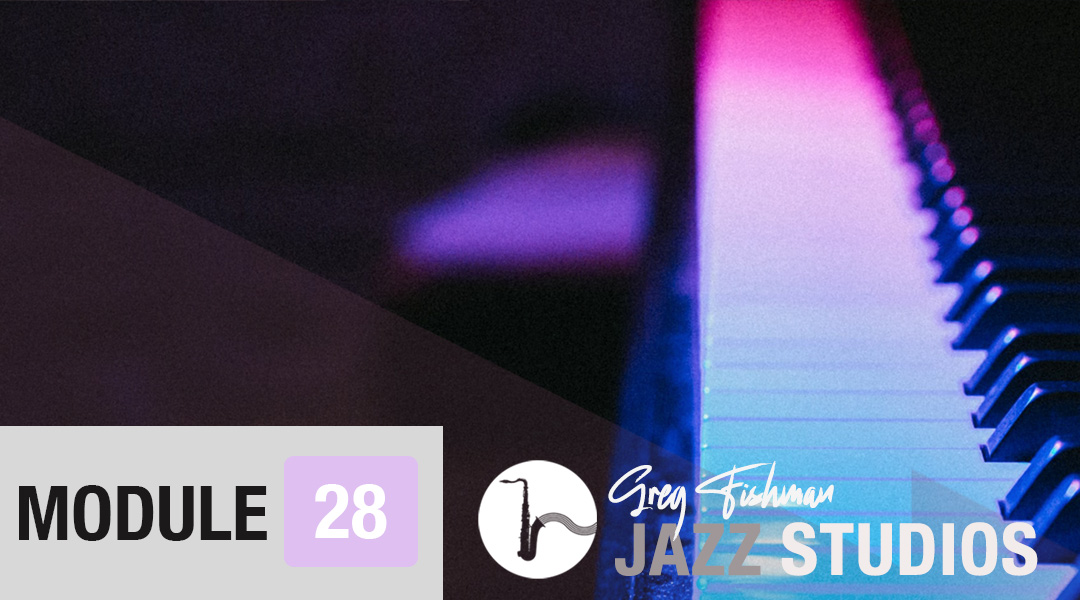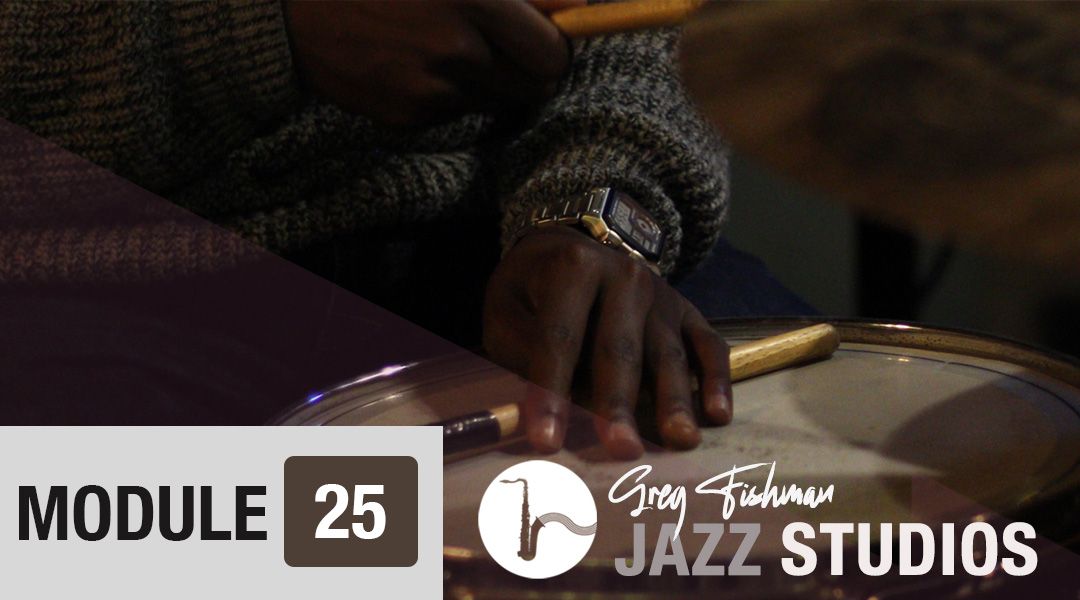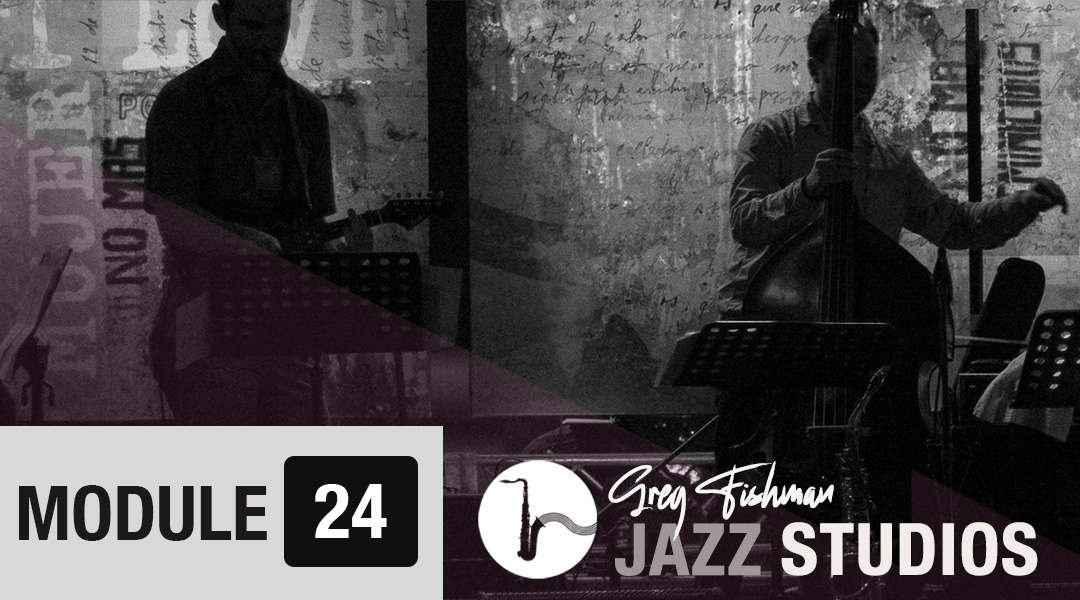5 Lesson course
MODULE 34
5 Lesson course
MODULE 33
4 Lesson course
MODULE 32
4 Lesson course
MODULE 31
5 Lesson course
MODULE 30
5 Lesson course
MODULE 29
5 Lesson course
MODULE 28
5 Lesson course
MODULE 27
5 Lesson course
MODULE 26
MODULE 35
5 Lesson course
MODULE 34
5 Lesson course
MODULE 33
4 Lesson course
MODULE 32
4 Lesson course
MODULE 31
5 Lesson course
MODULE 30
5 Lesson course
MODULE 29
Module 35
LESSON 1: Exploring Hip Lick #9
In this video lesson, I explore Hip Lick #9, extending the lick with the same ii / V chords, as well as making the lick resolve to a I maj7 chord. I also demonstrate the effect of starting the lick in four different locations; beats 1,2,3 & 4. In addition, I also demonstrate the lick in 12 keys. Includes detailed PDF practice notes for Bb, Eb & C instruments. INTERMEDIATE LEVEL.
LESSON 2: Major II V I vs. minor II V I – Apples to Apples Comparison
In this video lesson, I’ll give you an “apples-to-apples” comparison of a line played over a major ii / V / I and then that same line, harmonically adapted to fit a minor ii / V / i. If you’ve ever felt unsure about the sound of the minor ii / V / I, this video will put things clearly into focus. Includes detailed PDF practice notes for Bb, Eb and C instruments. INTERMEDIATE LEVEL.
LESSON 3: Bebop line over the bridge of “I Got Rhythm” from Two Voice-leading Lines
In this video lesson, I show you how I constructed a Bebop eighth-note line over the bridge of “I Got Rhythm,” using two voice-leading lines to nail the changes. Next time you’re playing “Oleo,” play this line on the bridge, and you’ll hear how clearly this approach outlines the changes. In the lesson, first I’ll play the eight-measure line for you and then I’ll deconstruct it, going step-by-step through the process I used to construct the line. Some very good and practical information about using the Bebop scale in this lesson, as well. Includes detailed PDF practice notes for Bb, Eb and C instruments. INTERMEDIATE LEVEL.
LESSON 4: Palm Key Hand Position Exercise
In this video lesson, I share my system for fixing years of poor palm key finger positioning. Most intermediate players, or even advanced players with poor left-hand palm key technique, tend to play with flat, straight fingers when it comes to playing the palm keys.
This causes a lack of fluency when switching between the palm keys and the lower range of the horn. In order to achieve fluency of technique, you will need to keep the fingers as curved as possible while pressing the palm keys. This lesson presents a three-step approach to gaining control over the palm keys.
There are no PDF notes with this lesson, as it’s best that you watch the video and imitate the moves on your horn. INTERMEDIATE & ADVANCED LEVEL.
LESSON 5: Listening Recommendation: Stan Getz – Focus
This Stan Getz masterpiece from 1961 is simply like no other record. This was Stan’s own favorite album of all of his many wonderful recordings. It’s a suite of seven pieces with a string orchestra, composed and arranged by the great Eddie Sauter.
Stan’s part is completely improvised, and the freshness and searching quality of his improvisations make this a truly unique classic. It’s not “straight-ahead,” though. Sort of a hybrid between jazz and classical. Highly recommended.
Module 34
LESSON 1: Four Directions – Thinking Locally and Globally
I often mention practicing in four directions for gaining mastery over your scales, chords and intervals. In this video lesson, I explore and explain the four directions. I describe the difference between thinking “locally” and “globally” when playing a sequential pattern.
LESSON 2: Finding the hidden Diminished and Augmented Chords in the Chromatic Scale
In this video lesson, I show you how to use the chromatic scale to diminished chords and augmented chords. Although I demonstrate these same chords in different video lessons (playing all of them on piano), this is an alternative approach, designed to help players that find it a real challenge learning the traditional way.
LESSON 3: Exploring Hip Lick #37
In this video lesson, I work with lick #37 from the book “Hip Licks for Saxophone Volume 1.” This is a two-measure C7 lick that uses part of the bebop scale, contrary motion, sequence and a diatonic enclosure.
In this video lesson, I share my technique for this popular special effect tonguing used by Getz, Bird, Pres and many of the top players from the Swing/Bop era. This one is intentionally an “all-ear” lesson, so there are no practice notes on this one.
LESSON 5: Listening Recommendation: Clifford Brown • Max Roach
This amazing 1958 album has so many classics…Daahoud, Joy Spring, Jordu, Parisian Thoroughfare…all on the same album. The beauty and symmetry of Clifford’s playing throughout this album is breathtaking.
Module 33
In this two-part video lesson, I take you through the essentials of voice leading, introducing you to the concept from the keyboard, making it very easy for your ear to follow along.
This video lesson continues where part 1 left off, showing you how to take the individual voice leading lines and combine them to form melodies.
In this video lesson, I demonstrate the concept of melodic embellishment, using my composition “Chicago Avenue” from “Jazz Phrasing for Saxophone, Volume 1.” This is a medium tempo swing piece based on chords similar to “Satin Doll.” In the lesson, I’ll show you how I embellish the original melody of Chicago Avenue by connecting new notes to the original melody.
Recorded in 1958, this masterpiece by the Hi-Lo’s is one of my favorite vocal jazz albums. The Hi-Lo’s, comprised of four male vocalists: Clark Burroughs, Gene Puerling, Bob Strasen and Bob Morse.
Module 32
Perhaps you’re familiar with the term “Bebop Scale.” The most common form of the scale is to play a descending Mixolydian scale with the addition of a major seventh. This extra note causes a shift in the placement of the notes in the scale, shifting the primary chord tones on the downbeats.
In part 2 of this lesson the Bebop Scale highway, I demonstrate how to combine different exits for the descending or “Southbound” form of the scale. I also introduce four different exits for the ascending or “Northbound” version of the scale. Includes detailed PDF practice notes for Bb, Eb and C instruments. Intermediate and advanced level.
In part three of this lesson, I demonstrate several different ways to practice the scale and the variations as I play along with Aebersold Volume 16 at a slow practice tempo and also at a fast, professional level tempo. Includes detailed PDF practice notes for Bb, Eb and C instruments. Intermediate and advanced level.
Recorded in 1967, this masterpiece by Antonio Carlos Jobim is one of my favorite albums, in no small part because of the incredibly beautiful arranging and orchestrations of the great Claus Ogerman. Jobim, himself is on piano and guitar, and Ron Carter is playing bass.
Module 31
In this video lesson, I demonstrate the concept of melodic embellishment, using my composition “Ogden Avenue” from “Jazz Phrasing for Saxophone, Volume 1.”
This is part one of a three part in-depth lesson on the usage of lower and upper neighboring tones.
This is part two of a three part in-depth lesson on the usage of lower and upper neighboring tones. I use the fun analogy of cake, frosting, and sprinkles to show you how to apply lower and upper neighboring tones on major and minor chords.
This is part three of a three part in-depth lesson on the usage of lower and upper neighboring tones. I use the fun analogy of cake, frosting, and sprinkles to show you how to apply lower and upper neighboring tones on major and minor chords.
One of my all-time favorite Count Basie albums, E=MC2. Neal Hefti arrangements. The band is just smokin’ on this one. I love the close miking, as well. Feels like we’re in the same room with the band. The Basie band conveys such power, but it’s never forced. Beautiful buoyancy to the feel. Great solos. A great addition to any serious jazz collection.
Module 30
In this video lesson, I demonstrate the concept of melodic embellishment, using my composition “Milwaukee Avenue” from “Jazz Phrasing for Saxophone, Volume 1.”
In this video lesson, I show you what I call the “Dexter Bb Shake.” I named it for Dexter Gordon because I first noticed the way that he used the effect.
In this video, I demonstrate an intense style of articulation that I learned from listening to one of my favorite players, the great Sonny Rollins. Sonny has an incredible amount of energy and power in his playing, and he’s developed an incredibly percussive style of articulation which introduces short notes in the middle of fast-moving eighth-note lines.
In this video, I discuss one of my favorite Sonny Rollins albums, “Sonny Rollins Plus 4.” This is on the Prestige record label, recorded in 1956.
Module 29
In this video lesson, I share some essential voice-leading strategies which will transform your chord arpeggios, making them sound smooth and professional.
In this video lesson, I share some essential voice-leading strategies which will transform your chord arpeggios, making them sound smooth and professional.
Hip Lick #49 is based on Cmi7. It’s a two-measure lick that outlines the primary notes of the chord (7-5-3-1) while also including some popular bebop elements, such as the opening triplet rhythm on the first beat.
Many students come to me with the same issue…they want to have a smooth sound when playing eighth-note lines, but no matter how slowly they practice, they still have a “choppy” sound. This is a tricky problem to correct because it has several causes.
In this video, I discuss one of my all-time favorite albums, Marcos Valle’s “Samba ’68.” It’s deceptive because it sounds so light and fluffy and simple. Actually, it’s incredibly deep, sophisticated writing with some of the catchiest melodies I’ve ever heard.
Module 28
In this video lesson, I share some of my techniques for getting the sounds in your head to come out on your horn.
In this video lesson, we’ll explore one of my favorite harmonic settings a minor second interval, acting as the 3rd / 9th / 3rd of a minor seventh chord. This has a very Getzian kind of sound…smooth and melodic. Includes page 22 from “Intervals in Action,” plus detailed PDF practice guide for C, Bb and Eb instruments. INTERMEDIATE LEVEL
In this video lesson, I explore what I call the “Phil Woods” turnaround lick. It uses two voice-leading notes to create a beautifully balanced, melodic line of eighth-notes.
Part of the bebop tradition involves the usage of both upper extensions and implied harmony. The mixing of the minor triad with a diminished seventh chord adds a strong harmonic boost to any minor passage.
In this video, I discuss one of my all-time favorite albums, Charlie Parker’s masterpiece album, “Charlie Parker with Strings.” The album features popular standards from the Great American Songbook, arranged for the strings-plus-rhythm section. Parker at his most eloquent. One of my all-time favorites.
Module 27
In this video lesson, you’ll observe me working with my Skype student Ritchie Graham (in Scotland). Over the years, many students have struggled with this double-time passage that I composed for my etude “Ravenswood Avenue.”
LESSON 2: Confirmation Changes / Hyde Park Blvd w/Aebersold
In this video lesson, I’ll show you how to nail the changes on Confirmation through good voice-leading, demonstrated in my contrafact for Confirmation, titled “Hyde Park Boulevard.”
In this video, I read the first chapter of my book, “The Lobster Theory.” This chapter is called “Lifting Weights,” and it’s about the importance of practicing each day.
In this video lesson, I’ll show you a very cool Sonny Stitt triplet pattern that works great over a ii mi7 / V7 progression.
In this video, I discuss one of my all-time favorite albums, guitarist Wes Montgomery’s 1966 Verve album, “Tequila.”
Module 26
In this four-part lesson, I’ll show you my process for transcribing solos. This lesson is really dense and packed with tips and techniques for transcribing. For the demonstration of how to transcribe, I’ve selected the first chorus of a Sonny Stitt blues called “Down With It.”
In the old days, none of this technology existed, and I would transcribe from a cassette player, and then directly from a CD player (which still actually works pretty well). The main thing to remember is to be very patient while transcribing and to have lots of patience with yourself and with the process.
In this video lesson, I’ll show you a very cool and useful pattern based on a triplet rhythm, using the chromatic scale. This pattern works incredibly well to nail the changes of a minor ii / V / i chord progression.
In this video, I discuss one of my all-time favorite albums, the Kenny Burrell & John Coltrane album on the Prestige label. The album features lots of catchy bebop-oriented tunes plus one ballad with Coltrane duet with Kenny Burrell on guitar. Great album!
Module 25
In this video lesson, I’ll show you how to work with Hip Lick #8 from my book, Hip Licks for Saxophone, Volume 1.
In this video lesson, I demonstrate how I like to use the 4th of the scale or chord to create tension and then resolve the note to the 3rd or 5th. Many aspiring players have been told that the 4th is an “avoid note.” This is very bad advice because all players need to know how to deal with this note when it comes up. You can’t just ignore it or avoid it.
Many group members have written to me, asking for a video lesson teaching them how to get a big, powerful sound on their palm keys. In this video, I share my unique approach to getting a full, big tone on the palm keys.
If you’ve ever had trouble getting a nice sound on your palm keys, this video will be transformative. Includes PDF lesson notes. INTERMEDIATE LEVEL
In this video lesson, I share what I call the “Coltrane Triplets.” This is a way of practicing your chord arpeggios with triplets.
CLICK HERE to download PDF lesson materials
In this video, I discuss one of my all-time favorite albums, Dave Brubeck’s monumental 1959 recording, “Time Out,” featuring the great Paul Desmond on alto.
Module 24
In this video lesson, we work with Hip Lick #11. This is an extremely useful lick. It’s just six notes, and it fits a Dmi7 chord, a G7 chord, or both chords, with the first four notes of the lick over the Dmi7 and the final two notes over the G7 chord.
In this video lesson, I take you through the seven note tape measure® scales in all four directions, played in the cycle. There are some very interesting note groupings on this one, with some shifting accents as you change keys.
In this video lesson, we’ll explore 34 different harmonizations of a perfect 5th interval.
I have played all of the chords on the piano, placing the interval in the upper voice of the right hand. Focus on the way that the sound of the interval changes with each new chord. Important: In order to use the PDF play-along and read it without having to transpose, be sure to select and play the video that corresponds to the key of your instrument (C, Bb or Eb). Intermediate & Advanced level. Includes PDF of Intervals in Action page 69, which corresponds to the video.
In this video, I play the chord arpeggios, followed by the perfect fifth interval of C to G on the tenor. A transcription of this performance is included as a PDF with this lesson.
This is the piano accompaniment video for all Bb Instruments. The piano will play all of the chords from page 69 of “Intervals in Action.” Play the notes C to G and notice the unique sound of the interval over each of the thirty-four chords.
This is the piano accompaniment video for all Eb Instruments. The piano will play all of the chords from page 69 of “Intervals in Action.” Play the notes C to G and notice the unique sound of the interval over each of the thirty-four chords.
This is the piano accompaniment video for all Concert C Instruments. The piano will play all of the chords from page 69 of “Intervals in Action.” Play the notes C to G and notice the unique sound of the interval over each of the thirty-four chords.
In this video, I discuss one of my all-time favorite Sonny Stitt albums, Personal Appearance, recorded in 1957.

